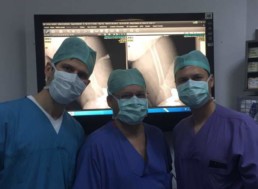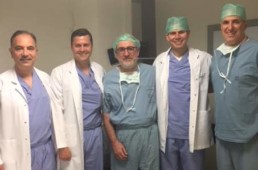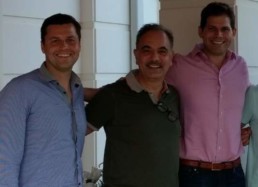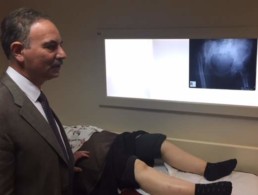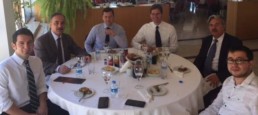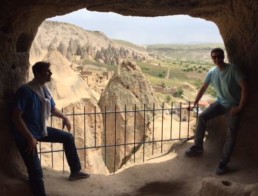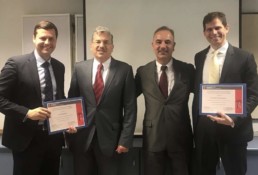EHS Travelling Fellowship 2018 Report by George Grammatopoulos and Christian Merle
The destination of the European Hip Society’s 2018 Travelling Fellowship was Turkey and the venues were split between the two largest cities (Ankara and Istanbul). We were extremely fortunate to have fantastic hosts. Professor Mazhar Tokgözoglu and Professor Bülent Atilla are two of the most renowned hip surgeons both nationally and internationally; they had prepared an exciting, well-balanced and broad agenda covering all aspects of hip surgery for our time spent in Turkey; their hospitality was second to none; their entire team gave us a very warm welcome from the moment we landed at Ankara Esenboga International Airport until the last moments of our stay.
Our experience started with an extremely busy outpatient clinic at the Hacettepe University Hospital in Ankara. The medical school of Hacettepe University was founded in 1963 and is internationally recognised as one of the top medical schools in Turkey. Our introduction with the team took place over a glass of Cay, which was in true tradition served with every opportunity. In the outpatient clinics we reviewed and intensely discussed about the diagnosis, clinical examination and treatment options for patients with complex hip pathologies. Those included Crowe 2 – 4 neglected DDH cases, post-traumatic hip deformities, aseptic loosening around 20-25 year old THAs and lastly THAs in spastic paraplegia and paediatric neurologic conditions. Following a stimulating clinic session, we were cordially invited to join the team for an authentic Turkish lunch at the University’s terrace restaurant. Whilst enjoying the panoramic views of the city and getting to know each other, a 4-course meal of excellent quality (…and quantity) was lightening our spirits. In the afternoon we learned about the team’s experience with complex THAs in DDH of variable severity including their experience with acetabular and femoral reconstructions using femoral autograft for the acetabulum and a plate to augment the femoral shortening osteotomy, whilst using a standard primary uncemented stem and cup.
Our second day was Labour Day (1st of May) and hence no clinical duties were undertaken. Professor Atilla showed us the Anatolian Civilisations Museum, one of the most impressive museums we have ever been to. The region’s rich cultural heritage was beautifully and elegantly displayed, spanning a period of over 11,500 years. We were amused to see transcripts crafted in stone from 1300 BC, illustrating that not much has changed in human behaviour, dealing with aspects of human life, friendship, marriage, taxes, war, divorce and wills. Following a visit to the castle, Professor Atilla and his wife invited us to their beautiful home, where we enjoyed a delicious Turkish feast. They both made us feel most welcome, reflecting Turkish hospitality at its best. (Continues…)
Our 3rd to 5th days were full of lectures and operating theatre experience. We visited Cankaya private hospital on Wednesday, an excellent and well-organised orthopaedic clinic. We spent time with Professor Tandogan and Dr. Kayaalp discussing indications, surgical techniques and outcomes in hip arthroscopy. We had the opportunity to observe 2 FAI cases elegantly and effectively treated arthroscopically. Thursday and Friday of week 1 were again spent at Hacettepe University Hospital joining Professor Tokgözoglu and his team for a THA in a Crowe 4 DDH case with subtrochanteric shortening osteotomy, impressively demonstrating all aspects we had covered in lectures earlier in the week. Thereafter, we participated in an open dislocation of the hip for the treatment of FAI, with a very effective restoration of functional, impingement-free range of movement after re-shaping of the femoral head-neck junction. On Friday, following talks on hip preservation by Drs. Yilmaz and Aksoy (Paediatric Orthopaedic Team), we joined Professor Atilla for a nicely executed anterior approach for open FAI treatment. This was followed by a complex revision of a loose stem in a previously 4-times revised THA. Albeit the difficulties associated with the case, surgery was performed effectively and very well controlled with a great post-operative outcome.
Following the day’s work, our weekend started by renting a car and driving to Cappadocia in central Turkey, providing us with a unique insight in the regions rich cultural heritage. We visited Christian churches and underground cities carved into the region’s unique volcanic soft rocks (‘Fairy Chimneys’), the Ihlara valley/canyon, Göreme’s UNESCO world heritage open air museum and a pottery museum with ancient and contemporary art. All this was accompanied by an outstanding and broad experience in Turkish cuisine.
The second week started with lectures at Hacettepe by Professor Yazici and invited Professor Ömeroglu discussing about cerebral palsy, neuromuscular hip problems, the hip-spine syndrome in young patients, neglected DDH cases and its differentiated surgical treatment with various concepts of acetabular and femoral reconstruction. Thereafter, on Tuesday we joined Professor Tokgözoglu in the operating room for a complex 3rd time revision with an extended trochanteric osteotomy of a 24-year old in situ revision THA with femoral allograft that was aseptically loose. Following a beautiful execution of the revision, we were again invited by Professor Tokgözoglu for lunch at the University’s restaurant and realised the both professional and social purpose of such a wonderful venue. During lunch colleagues of various disciplines (genetics and physiology) joined our table allowing for inter-disciplinary discussions and potential collaborations over great food. In the afternoon, we joined Dr. Ömür Caglar performing a complex primary THA for a Crowe 3 DDH with acetabular roof reconstruction using femoral head autograft.
The last day at Ankara started with our presentations during the morning conference prior to the trauma meeting. Christian talked about the variability of native anatomy in primary hip osteoarthritis and its implications for pre-operative templating, implant choice and subsequent patient reported outcome. George talked about hip-spine syndrome and outcome post-THA. Both presentations stimulated lively discussions. Thereafter, we made our way to the Department of Orthopaedics and Trauma Surgery at University of Ankara Hospital, which is the largest University Hospital at Ankara. Our host was Professor Kinik, an experienced and internationally renowned trauma surgeon who lead discussions on the treatment of hip and peri-prosthetic fractures. This was followed by observation of a very elegant surgery performed for the treatment of extra-capsular hip and peri-prosthetic distal femoral fractures respectively. We were also able to join Dr. Basarir performing a 2-stage THA procedure associated with significant proximal femoral bone loss for PJI. The OR set-up and team collaboration was very impressive at the hospital as 5 OR rooms used by the team are all joined by an open corridor, allowing for excellent inter-collegiate discussion and support.
We flew to Istanbul on Thursday and after checking in and settling in our nice hotel, we set out to explore the city’s Asian and European parts by taking the ferry from Kadiköy to Besiktas with fantastic views of the Bosporus during sunset. The last two days of our fellowship were committed to a primary and revision hip arthroplasty course chaired by Professor Atilla and organised on behalf of the Turkish Hip Society at Acibadem University. Acibadem University is a state of the art private university with world-renowned educational facilities. During the course, we were shown around the educational centre and had the opportunity to explore contemporary teaching tools such as virtual reality CPR training, virtual ultrasound, simulated OR rooms, delivery rooms, paediatric ICU, ER and pre-clinical rescue simulation. The unique surgical wet training lab has separate large rooms for laparoscopic, endoscopic, robotic and cadaveric training. The course was very well-organised with a good balance between lectures and cadaveric sessions. The lectures were held in Turkish with simultaneous translation to English, for which we were most grateful and which reflected the attention to detail and care our hosts provided us with during the entire visit. The course covered a wide spectrum of primary and revision topics and complex cases that were actively discussed within the small group of delegates and faculty. During the cadaver sessions we were able to perform primary and revision THA using various approaches, implants and restoration techniques. We were invited to join the faculty dinner at a fish restaurant on Bosporus with magnificent views of the Bosporus traffic and the European side. On our last meal in Turkey, we were fortunate to have our Turkish coffee cups read by a local lady, who provided interesting insight into our future and what it holds; this almost completed the full cultural experience we had on our to-do list.
We are grateful to our chiefs and departments (Prof. Ewerbeck, Department of Orthopadic and Trauma Surgery, Heidelberg University Hospital, Germany and Prof. Haddad, University College Hospital, London, England) for supporting our application and providing us with the time off in order to enjoy and learn from such a unique experience. Christian would like to thank Professor Murray and Professor Aldinger and George would like to thank Professor Beaule and Mr Andrade for their great support in the application process. We feel extremely honoured having been selected for this travelling fellowship. We would like to express our gratitude to the European Hip Society for the unique opportunity in making this happen. Mrs. Samantha Stokes deserves our special thanks for the excellent communication and organisation of the entire endeavour. We would like to say “çok teşekkür ederim” to Samet, Saygin and Ömür from Haceteppe for making us feel most welcome, showing us the city and providing us with tips on how to enjoy Ankara as locals. Finally, we will be forever grateful to Professor Tokgözoglu and Professor Atilla for their outstanding hospitality, perfect organisation, great attention to detail, and their care and humour. We leave Turkey with unique impressions and lots of new friends and look forward to coming back (Professor Atilla has promised to organise a traditional Turkish Hamam session, which is still on our to-do-list…).
THE END


